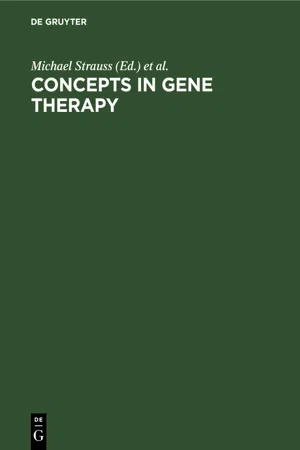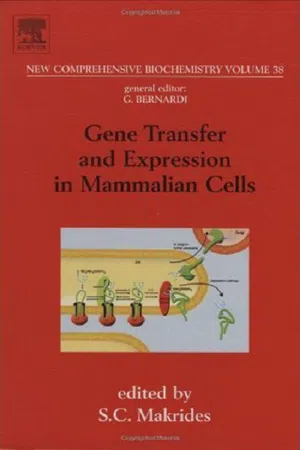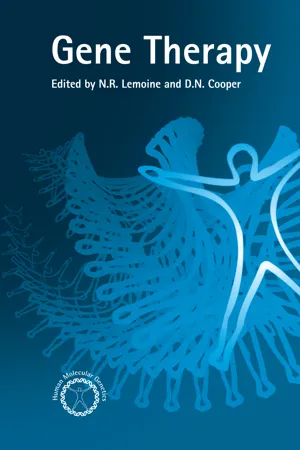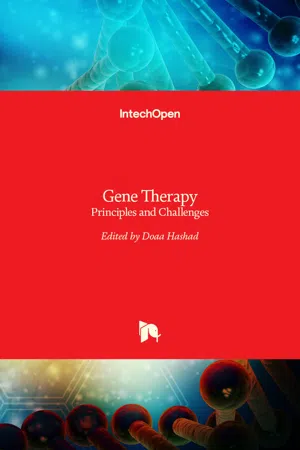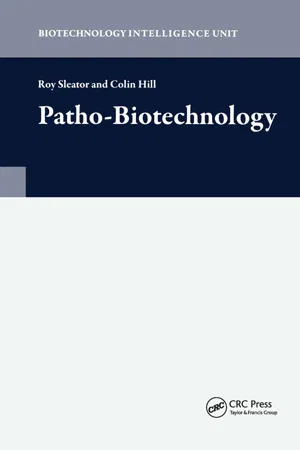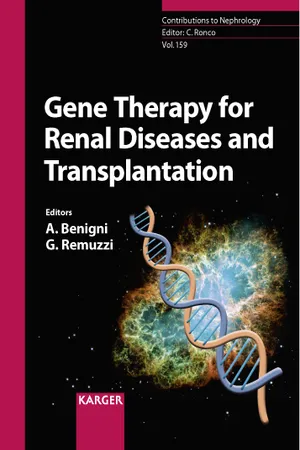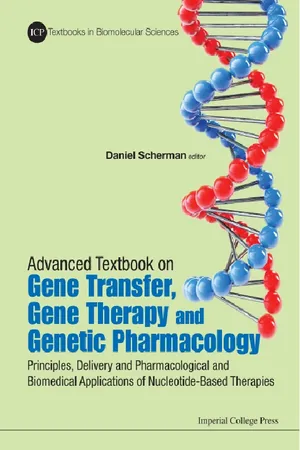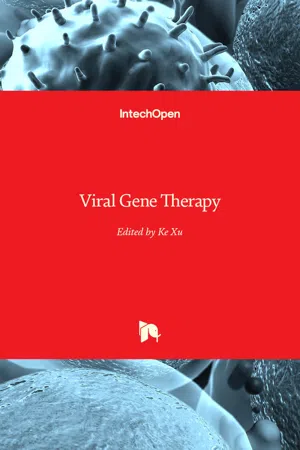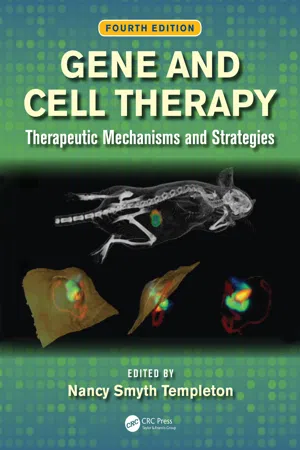Biological Sciences
Adeno Associated Virus Vector
Adeno-associated virus (AAV) vector is a small, non-pathogenic virus commonly used as a delivery system for gene therapy. It is capable of infecting both dividing and non-dividing cells, making it a valuable tool for introducing therapeutic genes into target cells. AAV vectors have shown promise in treating a wide range of genetic disorders and have become a popular choice for gene therapy applications.
Written by Perlego with AI-assistance
Related key terms
1 of 5
11 Key excerpts on "Adeno Associated Virus Vector"
- eBook - PDF
- Roland W Herzog, Sergei Zolotukhin(Authors)
- 2010(Publication Date)
- World Scientific(Publisher)
Chapter 6 Adeno-Associated Viral (AAV) Vectors Nicholas Muzyczka ∗ Adeno-associated Virus (AAV) is a non-pathogenic virus with wide tissue and species tropism. AAV vectors have proven to be safe and efficient for gene transfer to non-dividing cells, can generate long term gene expres-sion in a variety of animal models and can accommodate a variety of tissue specific and inducible promoter elements. Progress in understand-ing the biology of the virus has helped in the development of efficient and scalable production methods, and the simplicity of the viral structure sug-gests that it might be possible to design targeted vectors. Recent clinical trials also suggest that AAV will be useful in treating human disease. 1. Introduction AAV is a parvovirus, which are small, non-enveloped viruses that contain a linear, single-stranded DNA (ssDNA) that is about 5 kb. 1 AAVs have been isolated from a wide variety of vertebrate species, including humans, monkeys, cows, horses, birds, and sheep. Over a hundred variants have been isolated from primate and human tissues and a number of these have been characterized for gene therapy. Most humans ( ∼ 80%) are positive for AAV antibodies, but no human disease has been associated with AAV infection. The lack of disease association is one of the major safety features of AAV vectors. Over the last 10 years recombinant AAV (rAAV) vectors have become widely used as a delivery vehicle for modeling the treatment of various human diseases. More recently, rAAV has shown partial success ∗ Correspondence: Powell Gene Therapy Center, University of Florida College of Medicine. E-mail: [email protected] 87 A Guide to Human Gene Therapy in clinical trials 2,3 and promises to be an important therapeutic tool. - eBook - PDF
- Michael Strauss, John A. Barranger, Michael Strauss, John A. Barranger(Authors)
- 2020(Publication Date)
- De Gruyter(Publisher)
4. Adeno-Associated Viral Vectors D. M. McCarty and R. J. Samulski 4.1 Introduction Adeno-associated virus (AAV) based gene therapy research has been driven by our desire to employ the unique biology and life cycle of this human parvovirus. Few organisms exhibit as many natural features which seem to lend themselves to this purpose. The foremost property of this virus which suits it to applications in gene therapy is the tendency to establish latent infections by integrating into the chromo-somal DNA of non-permissive cells. Because permissivity generally depends on the presence of a co-infecting helper virus, this suggests that any uninfected cell could potentially serve as host for latent AAV. The second prominent feature which dis-tinguishes AAV from many other potential viral vectors is its lack of pathogenicity. Ostensibly, a virus which has never been associated with clinical disease poses rel-atively little risk when adapted as a vector. Other attractive characteristics are its stability, genetic simplicity, and ease of genetic manipulation. While each of these points remains valid, some obstacles to the application of recombinant AAV (rAAV) vectors have recently come to light. It is not surprising, given the cryptic nature of this virus, that new insights into its biology have surfaced only after extensive re-search with the rAAV vectors which are so much more easily detected. In this review we will discuss recent observations dealing with rAAV mediated transduction as well as some of the potential solutions that currently are being explored. 4.2 Recombinant AAV Vectors Genetic manipulation of AAV became possible when the viral genome was cloned into bacterial plasmids (1,2). Because these constructs contained intact palindromic terminal repeats (TR), which are the AAV origins of replication, it was possible to rescue the virus by transfecting the plasmid DNA into cells infected with adenovirus (Ad). - eBook - ePub
- S.C. Makrides(Author)
- 2003(Publication Date)
- Elsevier Science(Publisher)
Virus-based vectors for gene expression in mammalian cells: Adeno-associated virusXiao Xiao Department of Molecular Genetics and Biochemistry, University of Pittsburgh School of Medicine, Room W1244 BST, Pittsburgh, PA 15261, USA; Tel.: +1 (412) 648-9487; Fax: +1 (412) 648-9610 E-mail address: [email protected]Abstract Publisher SummaryThis chapter discusses the biology of adeno-associated virus (AAV). AAV is a non-pathogenic and replication-defective member of the parvoviridae family. AAV has no etiological association with any known diseases. Its propagation requires the co-infection of an unrelated virus, such as adenovirus or herpesvirus, to provide essential helper functions. Recombinant AAV vectors can be produced at very high titers (more than 1013 viral particles/ml) by several different methods. All these methods share the same three essential components: (1) AAV vector component that contains the foreign transgene(s) flanked by the 145-bp AAV inverted terminal repeats (ITRs). (2) AAV replication gene (Rep) and AAV capsid gene (Cap) genes that provide non-structural and structural proteins for vector DNA replication and packaging. (3) Helper functions from adenovirus or herpesvirus that facilitate efficient AAV propagation. When the three components above are introduced either transiently or stably into a suitable host cell, such as human 293 or HeLa cells, the AAV vector DNA is replicated and packaged into viral particles. AAV vectors have been increasingly used for gene transfer and gene therapy, particularly in vivo , because of the safety, high efficiency and long-term gene transfer by the vector system. In vitro and in vivo - eBook - ePub
- David Cooper, Prof Nick Lemoine(Authors)
- 2020(Publication Date)
- Garland Science(Publisher)
5Adeno-associated virus vectors for human gene therapy
Jeffrey S. Bartlett and Richard J. Samulski5.1 Introduction
Presently, human gene therapy is limited by the efficiency of stable gene transfer. To overcome this obstacle, adeno-associated virus (AAV) is being developed as a vector. This unique member of the parvovirus family possesses several properties which distinguish it from other gene transfer vectors. Its advantages include stable and efficient integration of viral DNA into the host genome (Berns et al., 1975; Cheung et al., 1980; Hoggan et al., 1972; Laughlin et al., 1986; McLaughlin et al., 1988), lack of any associated human disease (Berns et al., 1982), broad host range (Buller et al., 1979; Casto et al., 1967), the ability to infect growth-arrested cells (Wong et al., 1993), and the ability to carry non-viral regulatory sequences without interference from the viral genome (Miller et al., 1993a; Walsh et al., 1992). In addition, there has been no superinfection immunity associated with AAV vectors (Lebkowski et al., 1988; McLaughlin et al., 1988).AAV is a defective virus with a unique bi-phasic life cycle. It can be propagated either as a lytic virus or maintained as a provirus integrated into the host cell genome (Atchison et al., 1965; Hoggan et al., 1966, 1972) (Figure 5.1 ). In a lytic infection, replication requires co-infection with either adenovirus (Atchison et al., 1965; Hoggan et al., 1966; Melnick et al., 1965), or herpes simplex virus (HSV) (Buller et al., 1981; McPherson et al., 1985); hence the classification of AAV as a ‘defective’ virus. Vaccinia virus can also provide at least partial helper function (Schlehofer et al., 1986). When AAV infects tissue culture cells in the absence of helper virus, it establishes latency by persisting in the host cell genome as an integrated provirus (Berns et al., 1975; Cheung et al., 1980; Handa et al., 1977; Hoggan et al., 1972). Although AAV physically recombines its DNA into the host cell genome, it can be rescued from the chromosome and re-enter the lytic cycle if these cells are superinfected with helper virus. The lytic phase of the AAV life cycle requires the expression of the adenovirus early gene products (Richardson and Westphal, 1981) Ela (Chang et al., 1989; Richardson and Westphal, 1984), Elb (Richardson and Westphal, 1984; Samulski et al., 1988), E2a (Jay et al., 1979), E4 (Carter et al., 1983; Laughlin et al., 1982; Richardson and Westphal, 1981, 1984), and VA RNA (Janik et al., 1989; West et al., - eBook - PDF
Gene Therapy
Principles and Challenges
- Doaa Hashad(Author)
- 2015(Publication Date)
- IntechOpen(Publisher)
Among viral platforms for gene delivery, adeno-associated virus (AAV) emerged in 1965 and has attracted much attention since then because the virus is not pathogenic, does not induce significant immune response and/or toxicity to humans while it allows long-term transgene expression. 2. Emergence of rAAV as a therapeutic platform Adeno-associated virus was first discovered in 1965 as a contamination of rhesus monkey kidney cell cultures that were infected with adenovirus stocks [2]. Initially, the virus was called defective as it was incapable of self-replicating in the absence of a helper virus, adenovirus or herpesvirus. Later, it was classified as a member of the Parvovirus family, genus Dependovi‐ rus. Further investigation determined that it is a small virus (approximately 20 nm) composed of an icosahedral protein capsid, which contains single-stranded DNA of 4.7 kb. The viral genome is flanked at each end by inverted terminal repeats sequences of 145 bp called ITRs. These sequences self-assemble into hairpin structures, generating a double-stranded sequence, which serves as a template for replication. The viral genome encodes for two proteins: Rep and Cap. Rep is required for single-stranded DNA replication and packaging. Cap is necessary to form the viral capsid and transduce cells efficiently. AAV has never been associated with a disease or pathology [3]. Furthermore, due to the homology between the Rep-binding element present on the ITR, and the rAAVS1 sequence found on human chromosome 19, the viral genome can result in integration into the human genome [4]. This last feature is important because it shows that the virus can facilitate long-term expression of the viral genome. Additionally, specific integration of AAV in a defined locus minimizes the risks of mutagenesis due to random insertions, as other vectors do. However, several genetic modifications of AAV have been performed in order to guarantee further safety for its translation into the clinic. - eBook - PDF
- Dr. Roy Sleator(Author)
- 2008(Publication Date)
- CRC Press(Publisher)
Current strategies to improve Ad vectors involve using transductional targeting to redirect the virus to a novel receptor, genetic modification to increase tropism and use o f alternative serotypes, including nonhuman A d .38 Again, safety issues arise e.g., due to toxicity and host immune response. Adeno-Associated Viral Vectors Adeno-associated viruses (AAVs) are small, non-enveloped, single stranded D N A viruses, belonging to the parvovirus family.42 M ost AAV vectors are derived from AAV2 but different AAV serotypes, capable o f infecting different cell types have been identified.43 This is useful, as pseudotyping AAV2 with capsids from other serotypes can be carried out. AAVs are dependent V iral Pathogens as Therapeutic D elivery Vehicles 137 on a helper virus, usually adenovirus (or herpesvirus) to replicate. In the absence o f a helper virus, AAVs integrate into (a specific location in) the genome, establishing a latent infection. The D N A genome consists o f two genes; rep , coding for proteins which control viral replication, structural gene expression and integration into the host genome and cap, which codes for capsid structural proteins. At either end o f the genome are inverted terminal repeats (ITR s/TR s), which play a role in integration and rescue o f the AAV genome and are required in cis for viral D N A replication and encapsidation. W hen used as a vector, the rep and cap genes are replaced by the transgene and its associated regulatory sequences (Fig. 5). Production o f the recombinant vector requires that rep and cap are provided in trans, along with helper virus products (from the adenovirus genome). O ne method is to cotransfect two plasmids, one for the vector and the second for rep and cap, but this method has drawbacks—low yields, contamination with adenovirus and wild type AAV. - A. Benigni, G. Remuzzi, Claudio Ronco(Authors)
- 2008(Publication Date)
- S. Karger(Publisher)
Benigni A, Remuzzi G (eds): Gene Therapy for Renal Diseases and Transplantation. Contrib Nephrol. Basel, Karger, 2008, vol 159, pp 63–77 Adeno-Associated Virus Vectors: Versatile Tools for in vivo Gene Transfer Lorena Zentilin, Mauro Giacca Molecular Medicine Laboratory, International Centre for Genetic Engineering and Biotechnology, Trieste, Italy Abstract Over the last few years, viral vectors based on the adeno-associated virus have gained increasing popularity due to several favorable characteristics, including the high efficiency of transduction of postmitotic tissues in vivo and the long-term persistence of transgene expres-sion in the absence of inflammation or immune response. Recently, completed trials have sub-stantially confirmed the clinical applicability of these vectors, while indicating that further developments in vector design and production scale are necessary to broaden human applica-tion. This review summarizes our current knowledge on the molecular biology of these vectors and their clinical utilization, in particular concerning their application in renal gene transfer. Copyright © 2008 S. Karger AG, Basel Adeno-Associated Virus Vectors The adeno-associated virus (AAV) is a small nonenveloped virus with a diameter of 18–25 nm, which belongs to the Parvoviridae family and is classified in the Dependovirus genus. The wild type, 4.7-kb-long AAV genome contains two open reading frames, corresponding to the Rep and Cap genes encoding for the replicative and capsid proteins of the virus, respectively (fig. 1a). Through the use of two different promoters and the alternative inclusion of one exon, the Rep gene gives rise to four protein isoforms (Rep78, 68, 52 and 40). Three dif-ferent products (VP1, VP2, VP3) are also generated from the Cap gene after the alternative usage of three different translation start sites and of a common polyadenylation signal.- eBook - PDF
Advanced Textbook On Gene Transfer, Gene Therapy And Genetic Pharmacology: Principles, Delivery And Pharmacological And Biomedical Applications Of Nucleotide-based Therapies
Principles, Delivery and Pharmacological and Biomedical Applications of Nucleotide-Based Therapies
- Daniel Scherman(Author)
- 2013(Publication Date)
- ICP(Publisher)
The relative simplicity of the organization of the AAV genome and the non-pathogenic properties of the parental AAV have greatly contributed to the use of this viral vector among the gene transfer community. However, the limited knowledge of the wild-type virus compared with other viral vectors has required considerable effort to gain insight into wild-type AAV biology in order to be able to improve the AAV vector system for therapy. This review will summarize the most important features of both wild-type and recombinant AAV (rAAV) to show how the increased understanding of the biology of the virus and vector have enabled rAAV to lead the in vivo gene transfer field. 10.2 Wild-Type AAV Biology AAV was discovered in the early 1960s as a contaminant of adenovirus prepara-tions and soon thereafter classified as a member of the parvovirus family. Owing a INSERM U758-Human Virology Unit, Ecole Normale Supérieure de Lyon, 46 allée d’Italie, 69007 Lyon, France b Department I of Internal Medicine and Center for Molecular Medicine, Cologne, University of Cologne, Robert-Koch Str. 21, 50931 Cologne, Germany Email: [email protected] 152 Advanced Textbook on Gene Transfer, Gene Therapy and Genetic Pharmacology to its replication-defective phenotype, this virus, initially named “satellite”, defined a new genus within the Parvoviridae , the Dependoviruses . Indeed, further studies showed that this virus was unable to replicate alone but required the assis-tance of a helper virus. Besides adenovirus, the first helper virus identified and responsible for the term “adeno-associated”, other viruses have also been shown to be able to mediate the helper effect including members of the herpes virus fam-ily, herpes simplex virus (HSV) or Cytomegalovirus , and human papillomavirus (HPV) (Daya and Berns, 2008). This section will review the major properties of wild-type AAV derived from in vitro studies and in vivo analyses. - eBook - PDF
- Ke Xu(Author)
- 2011(Publication Date)
- IntechOpen(Publisher)
Pharm Res 2008; 25: 489-499. [25] Couto LB: Preclinical gene therapy studies for hemophilia using adeno-associated virus (AAV) vectors. Semin Thromb Hemost 2004; 30: 161-171. [26] Van Vliet KM, Blouin V, Brument N, Agbandje-McKenna M, Snyder RO: The role of the adeno-associated virus capsid in gene transfer. Methods Mol Biol 2008; 437: 51-91. [27] Halbert CL, Allen JM, Miller AD: Adeno-associated virus type 6 (AAV6) vectors mediate efficient transduction of airway epithelial cells in mouse lungs compared to that of AAV2 vectors. J Virol 2001; 75: 6615-6624. [28] Ho KJ, Bass CE, Kroemer AH, Ma C, Terwilliger E, Karp SJ: Optimized adeno-associated virus 8 produces hepatocyte-specific Cre-mediated recombination without toxicity or affecting liver regeneration. Am J Physiol Gastrointest Liver Physiol 2008; 295: G412-419. [29] Sen S, Conroy S, Hynes SO et al : Gene delivery to the vasculature mediated by low-titre adeno-associated virus serotypes 1 and 5. J Gene Med 2008; 10: 143-151. [30] Opie SR, Warrington KH, Jr., Agbandje-McKenna M, Zolotukhin S, Muzyczka N: Identification of amino acid residues in the capsid proteins of adeno-associated virus type 2 that contribute to heparan sulfate proteoglycan binding. J Virol 2003; 77: 6995-7006. [31] Belur LR, Kaemmerer WF, McIvor RS, Low WC: Adeno-associated virus type 2 vectors: transduction and long-term expression in cerebellar Purkinje cells in vivo is mediated by the fibroblast growth factor receptor 1 : bFGFR-1 mediates AAV2 transduction of Purkinje cells. Arch Virol 2008; 153: 2107-2110. [32] Asokan A, Hamra JB, Govindasamy L, Agbandje-McKenna M, Samulski RJ: Adeno-associated virus type 2 contains an integrin alpha5beta1 binding domain essential for viral cell entry. J Virol 2006; 80: 8961-8969. [33] Zhou SZ, Cooper S, Kang LY et al : Adeno-associated virus 2-mediated high efficiency gene transfer into immature and mature subsets of hematopoietic progenitor cells in human umbilical cord blood. - eBook - ePub
- Michael Chandler, Martin Gellert, Alan M. Lambowitz, Phoebe A. Rice, Suzanne B. Sandmeyer, Michael Chandler, Martin Gellert, Alan M. Lambowitz, Phoeba A. Rice, Suzanne B. Sandmeyer, Michael Chandler, Martin Gellert, Alan M. Lambowitz, Phoeba A. Rice, Suzanne B. Sandmeyer(Authors)
- 2015(Publication Date)
- ASM Press(Publisher)
Curr Top Microbiol Immunol 158: 97–129.[PubMed] [CrossRef]19. Buller RM, Rose JA. 1978. Characterization of adenovirus-associated virus-induced polypeptides in KB cells. J Virol 25: 331–338.[PubMed]20. Wistuba A, Kern A, Weger S, Grimm D, Kleinschmidt JA. 1997. Subcellular compartmentalization of adeno-associated virus type 2 assembly. J Virol 71: 1341–1352.[PubMed]21. Rolling F, Samulski RJ. 1995. AAV as a viral vector for human gene therapy. Generation of recombinant virus. Mol Biotechnol 3: 9–15.[PubMed] [CrossRef]22. Warrington KH, Gorbatyuk OS, Harrison JK, Opie SR, Zolotukhin S, Muzyczka N. 2004. Adeno-associated virus type 2 VP2 capsid protein is nonessential and can tolerate large peptide insertions at its N terminus. J Virol 78: 6595–6609.[PubMed] [CrossRef]23. Gao G, Vandenberghe LH, Wilson JM. 2005. New recombinant serotypes of AAV vectors. Curr Gene Ther 5: 285–297.[PubMed] [CrossRef]24. Xie Q, Bu W, Bhatia S, Hare J, Somasundaram T, Azzi A, Chapman MS. 2002. The atomic structure of adeno-associated virus (AAV-2), a vector for human gene therapy. Proc Natl Acad Sci USA 99: 10405–10410.[PubMed] [CrossRef]25. DiMattia M, Govindasamy L, Levy HC, Gurda-Whitaker B, Kalina A, Kohlbrenner E, Chiorini JA, McKenna R, Muzyczka N, Zolotukhin S, Agbandje-McKenna M. 2005. Production, purification, crystallization and preliminary X-ray structural studies of adeno-associated virus serotype 5. Acta Crystallogr Sect F Struct Biol Cryst Commun 61: 917–921.[PubMed] [CrossRef]26. Xie Q, Ongley HM, Hare J, Chapman MS. 2008. Crystallization and preliminary X-ray structural studies of adeno-associated virus serotype 6. Acta Crystallogr Sect F Struct Biol Cryst Commun 64: 1074–1078.[PubMed] [CrossRef]27. Padron E, Bowman V, Kaludov N, Govindasamy L, Levy H, Nick P, McKenna R, Muzyczka N, Chiorini JA, Baker TS, Agbandje-McKenna M. 2005. Structure of adeno-associated virus type 4. J Virol 79: 5047–5058.[PubMed] [CrossRef] - eBook - PDF
Gene and Cell Therapy
Therapeutic Mechanisms and Strategies, Fourth Edition
- Nancy Smyth Templeton(Author)
- 2015(Publication Date)
- CRC Press(Publisher)
After the genome is successfully delivered into the nucleus, a suc-cession of events converts the vector into larger concatemeric molecules. Most of these concatemeric molecules appear to be maintained for prolonged periods, perhaps for the lifetime of the cell, within the nucleus as episomal molecules, and very few if any integrate into the host genome [16,145,146]. 4.8.1 C ELLULAR B INDING AND T RAFFICKING OF AAV V ECTORS The ability of a vector particle to interact with a specific receptor molecule on a target cell is critical for successful transduction. The primary binding receptors identified as heparan sulfate and sialic acid are commonly found on many cells and are also the receptor molecules utilized by a large number of viruses besides AAV. This suggests that additional receptors that lend more specificity to the attachment and penetration of cells might exist and several such coreceptors have been identified (see Section 4.7.1). While cellular attachment is the critical first event, it does not necessarily imply that the vector will be able to efficiently transduce the cell. This has become increasingly apparent from a more detailed understanding of the trafficking and uncoating of AAV vectors [93–98]. For example, polarized human airway epithelial cells are transduced with varying efficiencies by AAV2-based vectors depending on the route of delivery and entry from the basolateral surface results in about a 200-fold increase in gene expression in the cells compared to vector administered from the apical surface [93,251]. Surprisingly, the difference in vector attachment to the two cell surfaces is only about fivefold. This finding led to the discovery that the vectors traffick differently in 99 Adeno-Associated Virus and AAV Vectors for Gene Delivery these cells depending on the side of the polarized airway to which they bind [93,251]. Vectors administered from the apical surface are modified by ubiquitination.
Index pages curate the most relevant extracts from our library of academic textbooks. They’ve been created using an in-house natural language model (NLM), each adding context and meaning to key research topics.

